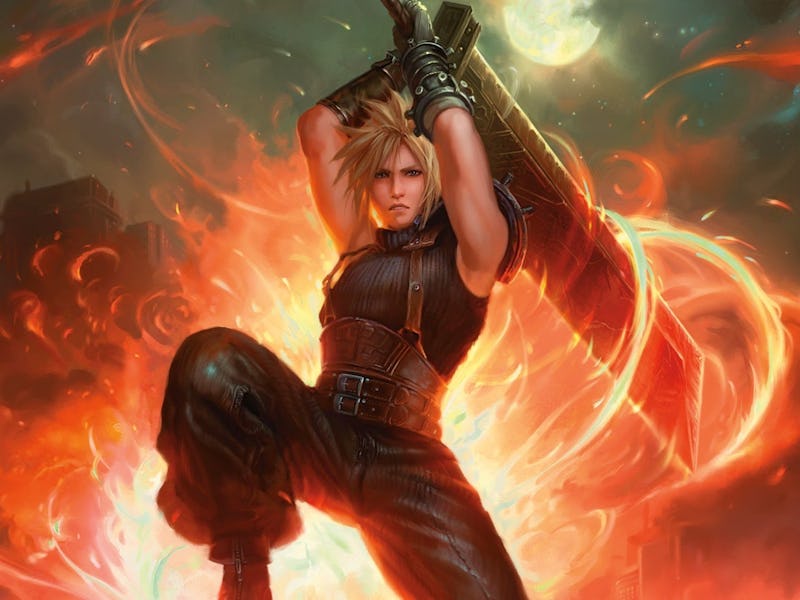
I worked at Target over a decade ago, and every payday, a group of guys from the backroom would drop $200 each on the newest shipment of Magic: The Gathering cards. As someone who obsessively collected things, I said then and there I couldn’t get into Magic... but then Final Fantasy came along. I want to get my grubby hands on these cards, not just because they look pretty, but because of how impressively the new Final Fantasy set adapts the video game’s ideas and mechanics. The set genuinely looks like a Final Fantasy fan's dream, and it’s enough to finally make me take the plunge.
Over the weekend, Magic revealed the full Final Fantasy set in a lengthy panel. While each of the 16 mainline Final Fantasy games is getting cards, there will be Commander Decks for Final Fantasy 6, 7, 10, and 14. You can see the full panel below, but we’ll pick out some highlights. One thing is already clear: this set is made by people with an intimate understanding of what makes Final Fantasy tick.
As someone with a basic understanding of Magic, what’s really impressive about the Final Fantasy set to me is how it's weaving the mechanics and stories of both franchises together to give these cards a unique spirit. There are so many smart elements, and it feels like every single one of the 16 games has been given equal care; nothing feels overlooked here.
This all starts with the set’s major new mechanics, specifically the iconic Final Fantasy job system. Job select is a new triggered ability found on equipment cards, letting you attach Hero creature tokens to Equipment that assigns a job. So far, we’ve seen job cards for the likes of Dragoon, Summoner, Black Mage, and White Mage, each of which has its own effects and boosts. It’s a brilliant little twist that adds an extra layer of strategy, and directly adapts one of Final Fantasy’s major mechanics.
This set also uses transforming double-faced cards to represent famous Final Fantasy bosses and their different phases. For example, Emet-Selch can transform into the fearsome Hades, and Sephiroth into Safer Sephiroth. Land cards are also getting shaken up with the addition of Towns, featuring beloved locations like Zanarkand or Midgar. This ties into Magic’s Adventure mechanic, with some new rules to add extra wrinkles. Summons are also being added as Saga Creatures.
All of these elements make the set feel unique, but what’s most impressive is the care put into so many of the individual cards — and how they tell a story. Take Kain from Final Fantasy 4. Whenever Kain deals combat damage to a player, that player gains control of Kain, but you get to draw cards. This is a clever way to represent Kain’s character, his questionable allegiances, and his tendency to betray the party.
Then there’s Lightning from Final Fantasy 13, and her card that directly adapts that game’s Stagger system. This gives you an opportunity to cause double damage, just like in the game. Final Fantasy 13 is also this set’s only instance of the Meld mechanic, which lets you fuse the Fang and Vanille cards into Ragnarok.
There are other fun little details, like the serialized Chocobo cards that come in five different colors. I could go on for days about how so many of these cards brilliantly adapt characters, stories, and mechanics, but perhaps the most important part of the set is its art design.
There are essentially three different visual flavors to these Final Fantasy cards, representing a wide swathe of styles and aesthetics. Magic’s artists have provided their own spin on characters, creatures, and locations, but this set also introduces “Final Fantasy Through the Ages,” which are cards that use art from the franchise’s decades of history.
Magic also worked with some of the series’ longtime artists to provide exclusive new art for certain cards, like one from Tetsuya Nomura for Sephiroth and one from Akihiko Yoshida for Balthier and Fran. The art is gorgeous, and helps represent the breadth and diversity the series has always been known for.
This is the most ambitious crossover set Magic has done, an unsurprising revelation considering this took a whopping five years to put together. Final Fantasy is one of the most legendary gaming series of all time, and it’s hard to think of how Magic could’ve tackled its complex history any better. No matter which game is your favorite, it’s represented here. This is the kind of thing I dreamed about when I was a 10-year-old kid, glued to both my TV and Game Boy, playing every Final Fantasy game I possibly could while looking for ways to import promotional soft drinks designed after the series’ Potions.
I’ve always been curious about Magic, but it seemed far too daunting and expensive. Final Fantasy feels like the bridge I need, because I understand it and all its complexities intimately. I’ve played countless card and tabletop games based on video game properties, but very few manage to actually capture the feeling and spirit of their source material. More often than not, it’s just a new skin applied to an old idea. It doesn’t feel like that here, as Magic has carefully crafted entirely new mechanics to translate Final Fantasy’s vibe. Stellar game design might just be the push I need to get hooked.
You can see a selection of the cards revealed during the panel below, and head to the official site for additional info.